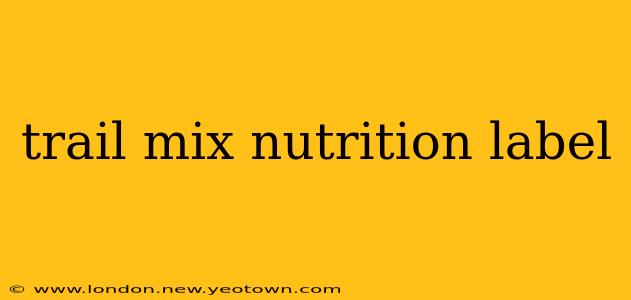Decoding the Trail Mix Nutrition Label: A Crunchy Adventure into Healthy Eating
Let's be honest, trail mix is awesome. A handful of salty, sweet, crunchy goodness—it's the perfect snack for hikes, road trips, or even a midday energy boost at your desk. But have you ever really looked at the nutrition label? It’s more than just a list of numbers; it's a roadmap to understanding the nutritional value (or lack thereof) of your favorite trail mix blend. This journey will uncover the secrets hidden within those tiny print details.
Imagine this: You're standing in the grocery store, faced with a wall of trail mix options. Each bag boasts enticing images and promises of energy and deliciousness. But how do you choose the healthiest option? The answer lies in understanding how to read the nutrition label.
What are the key components of a trail mix nutrition label?
This is where our adventure truly begins. The nutrition facts panel is your treasure map. It lists the following crucial pieces of information:
-
Serving Size: This is the crucial first step. Pay close attention to this, as it determines all the other values listed. A "serving" could be a small handful or a much larger portion, drastically changing your perception of the nutritional content.
-
Calories: This tells you the energy provided by one serving. Consider your daily caloric needs when evaluating this number.
-
Total Fat: Focus on the breakdown of saturated and unsaturated fats. Unsaturated fats (like those found in nuts and seeds) are generally considered healthier than saturated fats.
-
Cholesterol: This is usually low or absent in most trail mixes unless they contain dried meats or other high-cholesterol ingredients.
-
Sodium: Pay attention to the sodium content, especially if you're watching your salt intake.
-
Total Carbohydrate: This section breaks down into dietary fiber and sugars. Dietary fiber is beneficial for digestion, while added sugars should be consumed in moderation.
-
Protein: Trail mixes are often a good source of protein, especially if they include nuts, seeds, and dried beans.
-
Vitamins and Minerals: The label might list vitamins and minerals present, like iron, magnesium, or vitamin E. These can vary significantly depending on the ingredients.
How much sugar is in a typical trail mix?
This is a common question, and the answer varies wildly! The sugar content heavily depends on the ingredients. Mixes with lots of dried fruits will be significantly higher in sugar than those primarily composed of nuts and seeds. Check the label carefully, and be aware that even "natural" sugars from fruits can add up.
Is trail mix a healthy snack?
The healthiness of trail mix depends entirely on its composition! A mix rich in nuts, seeds, and a small amount of dried fruit can be a healthy and nutritious snack. It provides healthy fats, protein, and fiber, keeping you full and energized. However, mixes loaded with sugary candies, chocolate chips, or excessive amounts of dried fruit can be detrimental to your health due to high sugar and calorie content.
What are the best types of trail mix for weight loss?
For weight management, opt for trail mixes with a higher proportion of nuts and seeds and a lower proportion of dried fruits and added sugars. Look for options with lower calorie counts per serving. Portion control is also essential, even with the healthier options.
Can I make my own trail mix?
Absolutely! Making your own trail mix gives you complete control over the ingredients, ensuring you get exactly what you want nutritionally. This allows you to avoid added sugars, unhealthy fats, and excessive sodium, creating a truly healthy snack tailored to your needs.
The journey through the trail mix nutrition label doesn't have to be daunting. With a little knowledge and attention to detail, you can choose a mix that complements your healthy lifestyle. So, grab your bag of trail mix, take a closer look at that label, and enjoy your crunchy adventure knowing you're making informed choices for your well-being.

